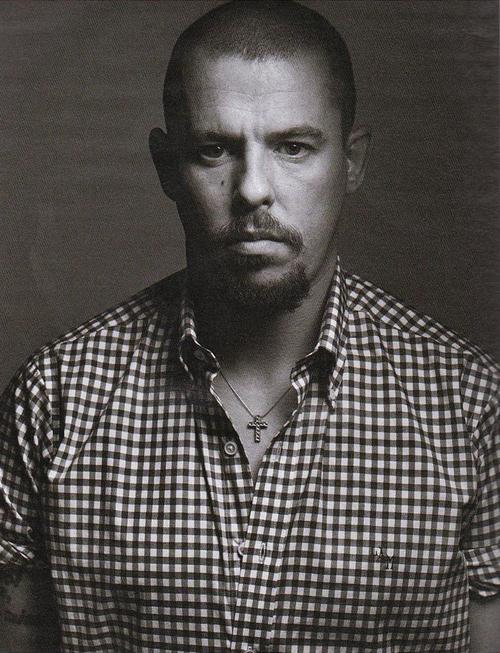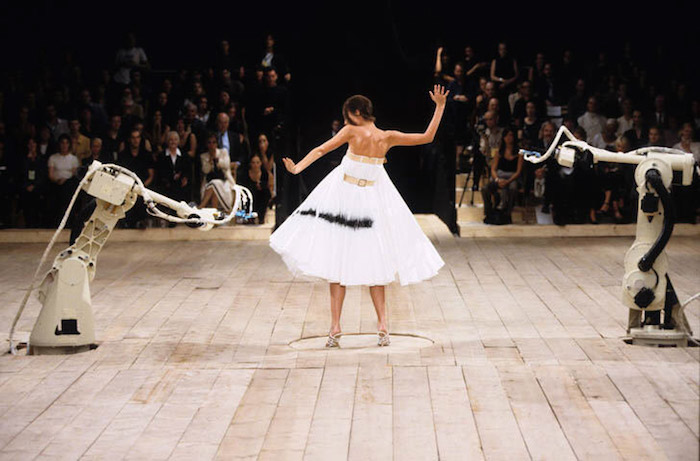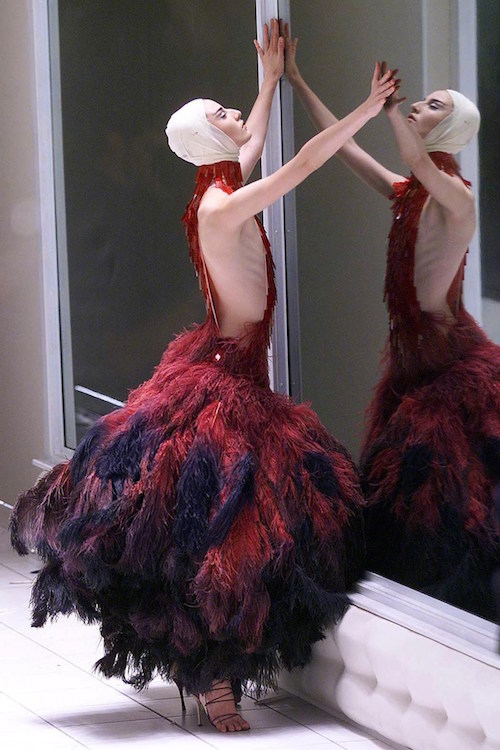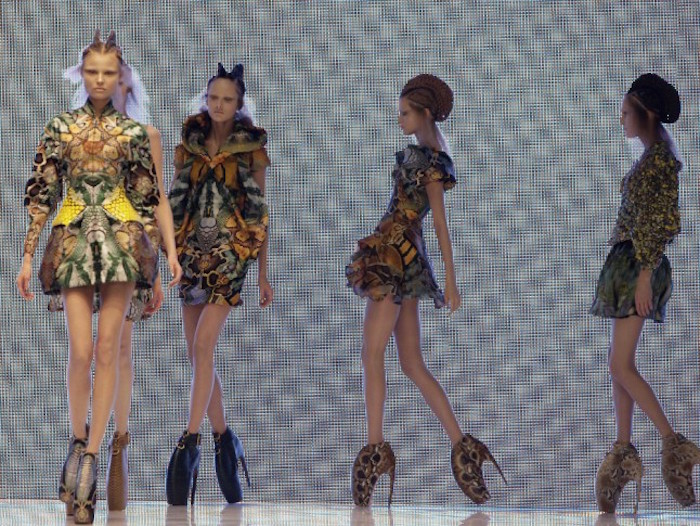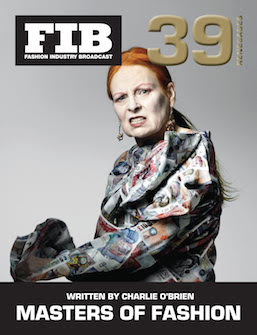By Charlie O’Brien
In honour of our upcoming “Masters of Fashion: Renegades” edition, we at Fashion Industry Broadcast are giving you a taste each week of the gifted and often troubled individuals that choose to forge their own paths in the fashion world. This week is the late, enigmatic Lee “Alexander” McQueen, whose dark yet innovative shows revolutionised fashion and fashion shows alike.
In February of 2010, rebel designer Alexander McQueen would shock the world one final time. After consuming a debilitating orgy of cocaine and sleeping pills he scrawled a note in his beloved drawing book; there, sidled between illustrations of Frankensteinian monsters and concept sketches for the romantically gothic pieces he had made his name crafting, he left a final message to the outside world:
Take care of my dogs. Sorry. I love you. Lee.
The next morning the housekeeper of his Mayfield home in London would find him dead, strung from the neck in his bedroom closet by his favourite belt. The fashion world was devastated by the news: not four months earlier they had risen in unison, fans and critics alike, and described his last collection as the best work he had ever produced – high praise for the man who, at just 23 years of age, found himself at the helm of one of the most respected Parisian fashion houses in the world and had consistently awed ever since.
But one only needed to look at the nature of the young designer’s work – the inherent violence and melancholy in every piece – to see there was a deep and permeable wound at the core of Lee Alexander McQueen; one forced onto him at an early age and repeatedly torn open with every criticism sustained and every looming deadline in which he was forced, again and again, to justify his undeniable talent. In so many ways, Alexander McQueen’s death reflected the nature of his work: savage, romantic, and steeped in tragedy.
Lee Alexander McQueen was born on 17 March 1969, into the working class suburb of Lewisham, London. His father was a taxi driver; his mother spent her days at home raising her six children –McQueen was the youngest – before entering the workforce as a social science teacher.
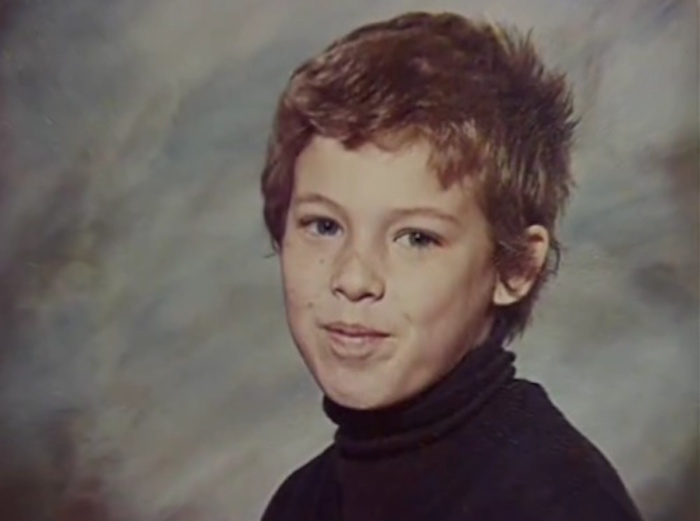
McQueen tapped into his creative side at an early age. With the encouragement of his mother he began designing dresses for his three sisters, the eldest of whom was separated by an age gap of 15 years. At the age of six he began to grapple with his homosexuality: as McQueen would later joke, he came “straight from his mother’s womb and into the gay pride parade.”
He may have been comfortable with his sexuality, but the area of London he was raised in was not famed for its acceptance. The family had moved from Lewisham to Stepney when McQueen was one. Stepney was an East End suburb of London synonymous with skinheads and general degenerates. While his mother and sisters were aware of McQueen’s sexual affiliation from an early age, his father and brothers were blue-collar workers at a time when acceptance of homosexuality was decidedly less than prolific. Even into adulthood, McQueen could remember countless instances when his father would divulge homophobic rhetoric at the dinner table: an uncomfortable scenario for a young gay man, to say the least.
School fared little better for McQueen in terms of acceptance. After years of being berated not only for his sexuality but also his unusually jutting teeth and continuous weight fluctuations, at the age of 16 he decided to drop out altogether. Conventional schooling held little interest for someone so consumed by his artistic passion: even in those early days designing dresses for his sisters he knew he could “be someone” in the world of fashion, and with his mother’s encouragement he began searching for a position as an apprentice tailor.
The experiences of childhood would come to define much of the McQueen aesthetic. McQueen recalled watching the birds of prey that hovered over his council flat for hours on end, fascinated by their effortless aerodynamics and the beautiful, intricate feathers that provided them with such effortless grace. “I’m inspired by a feather,” he would later say of his aviary muses, “its graphics, its weightlessness, its engineering.”
For McQueen, the bird was the ultimate representation of freedom. It was a natural beauty completely at odds with the seamy backdrop of Stepney, the teenage stomping ground that would provide another major source of inspiration in his career. Stepney was a working class neighbourhood, replete with all manner of addicts and prostitutes with whom McQueen and his friends, perennial night owls from an early age, would associate with on a frequent basis. There was a cache that came with being from the area: particularly in his early days as a designer when he was developing a reputation as the bad boy of British fashion. Yet for all its advantages there was a deep longing within McQueen to escape — not only the stifling nature of such a regressive suburb but the severe traumas he had experienced during his time there.
McQueen had been sexually abused by the husband of his eldest sister Janet from the age of nine. It was a personal shame he revealed to few in his life; so few, in fact, that Janet only became aware of the horrific and sustained acts four years before his suicide.
“The day I was told I was shell-shocked,” Janet told a British tabloid in the wake of McQueen’s death. “Can you imagine leading a life for so many years, and then finding out something as bad as that? You just can’t grasp it at first.”
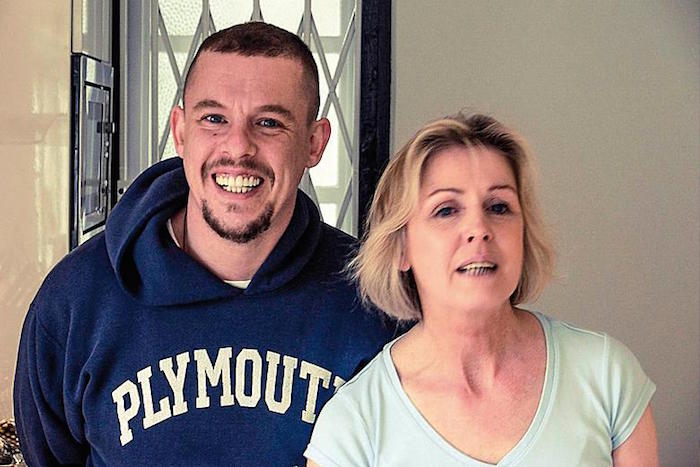
McQueen was not the only one to suffer at the hands of the husband. Janet was once beaten in public for having the audacity to order a cup of tea; at the hands of her former partner she suffered two miscarriages. On more than one occasion McQueen was forced to watch, helpless, as his eldest sibling was beaten to within an inch of her life. They were traumatic instances that, more than anything else, McQueen would carry with him the rest of his life; allowing them to inform his professional career and debilitate his personal relationships even as attempted to remove himself from the former world of Lee McQueen.
The transition to Alexander McQueen would begin at the famed Savile Row, a street in London renowned for exquisite bespoke tailoring. McQueen found work as an apprentice for Anderson & Shepherd, where he learned the painstakingly intricate techniques of suitmaking. It was rewarding but ultimately unsatisfying work for the young designer, whose ambitions extended beyond craftsmanship and into the realm of the artisan:
“I knew I couldn’t survive in a place like that for the rest of my life; cluttered in a small workshop, sitting on a bench, padding lapels. But I did have a passion and I was good at it. I was good at tailoring a jacket and I was quick at learning.”
McQueen found ways to amuse himself on his own terms. As he would later gleefully claim, he once sewed obscene messages into the lining of suits designed for Prince Charles himself. Upon hearing this, the management at Anderson & Shepherd hurriedly recalled every suit ever commissioned for the Prince; but, in a stellar example of the flagrant and disingenuous self-promotion McQueen would become known for, no messages were ever found. The young tailor transitioned through a number of reputable jobs through his teenage years: after leaving Anderson & Shepherd he moved to their competitor across the road, Gieves & Hawke, before arriving at thematic costumiers Angels and Bermans, whose work includes Star Wars, Titanic and Lawrence of Arabia.
At the age of 20, McQueen left the costumier industry to work for a brief period with avant-garde designer Koji Tatsuno before travelling to Milan and learning at the right hand of Romeo Gigli, an auteur Vogue claimed to be the “leading force in a new generation of designers proclaiming a different fashion sensibility.”
One of the most important lessons Gigli bestowed on his young disciple had little to with the sartorial trade itself. A designer, he said, could never truly flourish without a talent for self-promotion. It was an important piece of information McQueen would adopt time and time again through his own professional career.
McQueen returned to Britain at the age of 21, keen to transition his considerable experience into a teaching career at Central Saint Martins College of Art and Design, the prestigious fashion school that holds John Galliano and Paul Smith amongst its alumni.
Bobby Hilson, course director of the college at the time, recalls meeting McQueen on his first day:
“He was hovering outside my office, this rather unprepossessing lad, and I said to him ‘Who are you and what do you want?’ He said he wanted a job and I knew that was out of the question because he was about the same age as the students and they would have never taken him seriously. But I became more intrigued by him.”
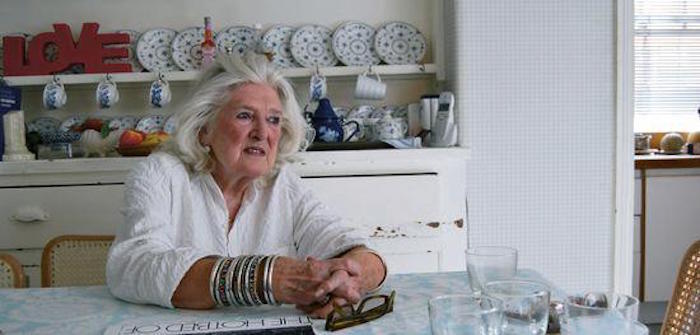
McQueen was offered a scholarship to the college instead. His time at Saint Martins would culminate in his first true collection: a dark, brooding and beautiful assemblage of pieces that would set the tone for his future work. “Jack the Ripper Stalks his Victims” was born from a personal connection with the famed serial killer – one of his ancestors owned an inn that housed some of his victims – and held traces of the morbid romanticism McQueen would later refine. Asymmetrical black jackets were corseted to the body of the models and complimented by pink silk satin dresses wrapped in a violent thorn patterning. His flair for the unusual was already on full display: a number of pieces were lines with human hair McQueen had sourced from his own scalp; a vivid callback to the Victorian prostitutes who sold locks of their own hair as fetishistic mementos.
The collection drew an uncommon amount of interest from a first-time designer; but there were no greater advocates for his early work than Isabella Blow, then editor of British Vogue and one of the most ostentatious characters in an industry spilling with the eccentric.
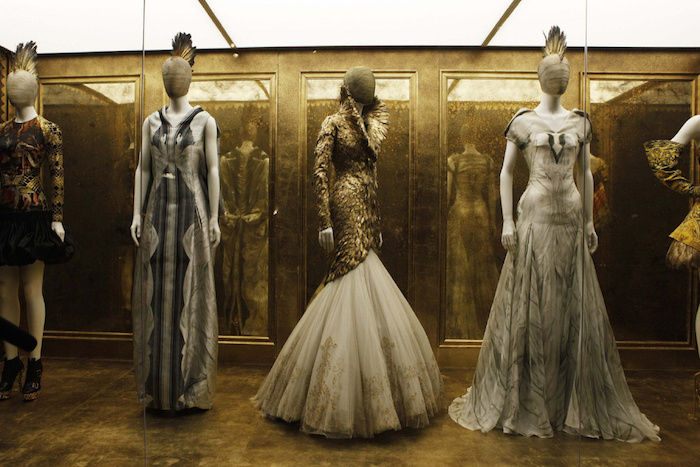
“I just knew he had something special,” Isabella later recalled. “Very modern. It was about sabotage and tradition. All the things, I suppose, that the nineties represent.”
Isabella had to have the entire collection. She called McQueen a half dozen times over the next week; when he finally answered he agreed to sell the entirety of his work for five thousand dollars. It was the beginning of one of the most famed relationships between designer and muse in modern fashion: one born from a mutual love of beauty and destroyed by the personal demons that plagued them both.
Isabella Blow was at once an aristocrat and an anarchist. She had been fired from editing positions at Tatler and American Vogue; she had stared down Anna Wintour and partied with Andy Warhol. Her theatrical presence and often absurd sense of style were matched by one of the most discerning eyes in fashion. Isabella was responsible for discovering hat designer Philip Treacy along with models Stella Tennant and Sophie Dahl. But there were none as close to her heart than Alexander McQueen.
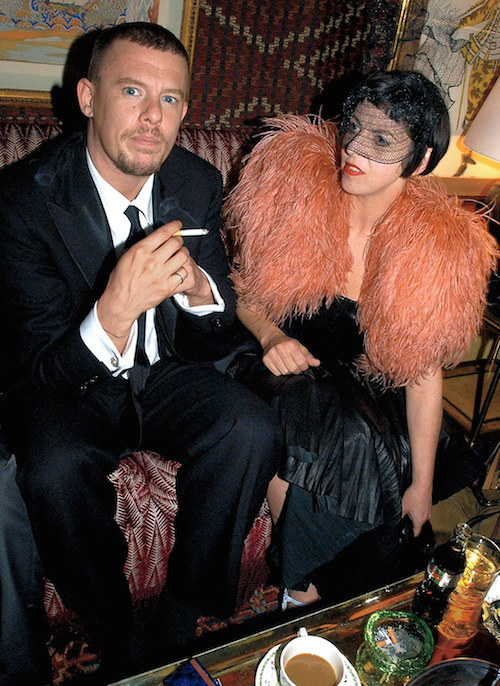
Isabella, like McQueen, held an air of the melancholic due to an unstable upbringing. She had been born into a crumbling aristocracy. Her grandfather famously stood trial from the murder of his wife’s secret lover: Josslyn Hay, the Earl of Errol.
He was acquitted of the crime but became a social pariah in the process; the shame over his fall from grace resulted in him taking a deliberately fatal overdose of morphine. The family estate was lost;the mansion rented out as a boarding school.
Isabella was raised in the shadow of the former family estate, on the periphery of the wealth and opulence she would later spend her life chasing. Family would cast a long and dreary shadow over her life: from the tragic death of her younger brother John in an accidental drowning to the emotional and physical distance between her and her parents, there were precious few warm memories to hold of her childhood.
Fashion was one of the few aspects that brought her joy. She would often tell those who would listen the pleasure she found in dressing up in her mother’s collection of exquisite hats, the simple joys in aesthetics many others take for granted but Isabella could never seem to do without.
In McQueen, she found a kindred spirit: one whose talent for design was perfectly complimented by sense of promotion and keen eye for style. But in order for their partnership to flourish they would need a studio – and the only one he could afford would return McQueen to his neighbourhood in the East End.
McQueen set up a bed behind the tiny studio and cobbled together a haphazard group of designers to work with him. Funding in those days was provided by Social Services, with the designer using his dole check to purchase the materials necessary for each collection. Runway shows were staged in backstreet factories using cheap models with either uncertain or undesirable reputations.
There was a kinetic energy to his earliest shows; a shock and awe approach designers now spend tens of thousands of dollars trying to imitate. It was an approach that extended to his radical new designs. The bumster was quintessential young McQueen: skirts, trousers and shorts cut to accentuate or outright flaunt the cleavage of the rear end.
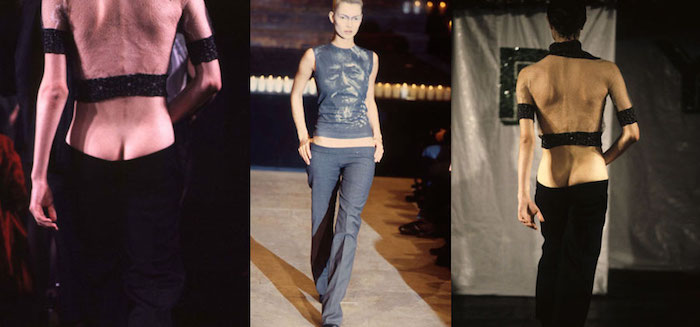
In the eyes of the designer the bumster accentuated the small of the back, an area he believed to be the “most erotic” feature of the human body; in the eyes of his critics, however, it was little more than a desperate attempt to garner attention for all the wrong reasons.
No doubt McQueen, with his growing penchant for sensationalism, was aware of this. But whatever the reason he and his cohorts were gathering attention. Under the considered promotion of Isabella Blow, a group of misfits from Saint Martins, Soho and East End were infiltrating an industry they had no right to be involved in. There was already considerable groundswell beneath McQueen when Isabella suggested a change in name: Alexander McQueen, a strategic ploy designed to evoke images of Alexander the Great.
It was a superficial change but an important one in the continued separation of Lee McQueen and his designer persona. But even as he stepped willingly in the character Isabella and the fashion media were creating for him, that of the British bad boy, the trauma he experienced in his former life as a Stepney lad was beginning to take grander influence in his designs.
The 1995 collection “Highland Rape” was the first time McQueen drew truly harsh criticism for his designs. Inspired by the ethnic cleansing of the Scottish Highlands – his ancestral home – by British Forces in the 18th and 19th centuries, the collection incensed many for its dark depiction of sexuality. Models staggered down the catwalk in pained movements and agonistic expressions, bodies spattered in blood and barely concealed by the torn dresses they were. The shock and awe of his previous collections remains: but it was imbued with a violence and sadness that stood it in stark contrast to the almost flippant design of the bumster.
There were obvious correlations to the ancestral history of Scotland, from the kilted skirts to the mossy green runway the models walked. But it was more personal than that. McQueen was using the painful past of Scotland to explore his own violent and sexual upbringing, and when accusations of misogyny ran rife through the fashion press in the aftermath of his fourth collection, McQueen passionately defended his design impetus from a very personal point of view:
“I’ve seen a woman nearly beaten to death by her husband. I know what misogyny is. I hate this thing about fragility and making women feel naïve. I want people to be afraid of the women I dress.”
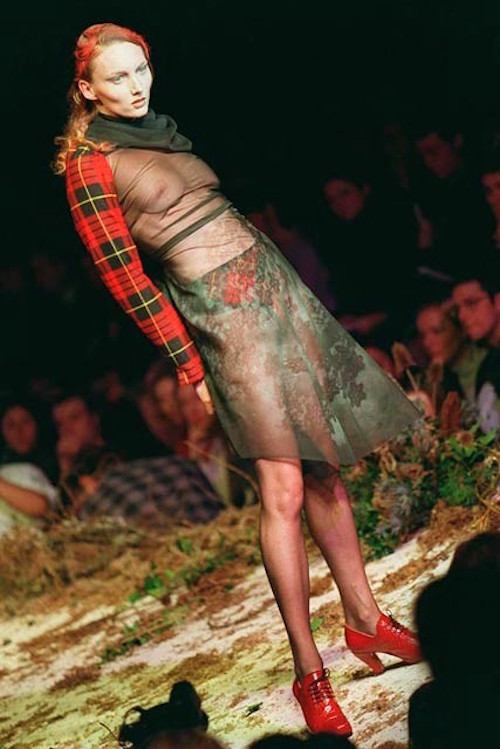
No one could deny that McQueen, based on his personal experiences, was creating clothing with the defense of women as a priority. He wanted to dress powerful and successful women in a manner that made them feel strong and self-assured. But there was also an inherent shrewdness to his provocation. McQueen had learned much from Romeo Gigli about developing a name through self-promotion; and despite the scorn thrown in his direction, the adage of “all publicity is good publicity” holds more weight in the fashion industry than perhaps anywhere else. The media claimed to detest the brash British upstart yet they never missed a show – and what McQueen prepared soon after would infuriate them even more.
German puppeteer Hans Bellmer, whose deformed creations were designed to oppose the myopic conventions of beauty during the Nazi regime, was the inspiration behind the 1997 collection “La Poupee.” Models were dressed as demented, fetishistic dolls, stray wires and strands protruding from them in an attempt to remove the pedestal upon which modern society views beauty; but the centerpiece of the evening, worn by African supermodel Debra Shaw, drew harsh criticism for not only its depictions of misogyny but the unforgivable sin of racism.
When critics witnessed Shaw shackled to rigid jewelry that contorted her movements into strange, angular motions they drew the most obvious and inflammatory accusations they could: it was exploitation; slavery gussied up as superficial couture.
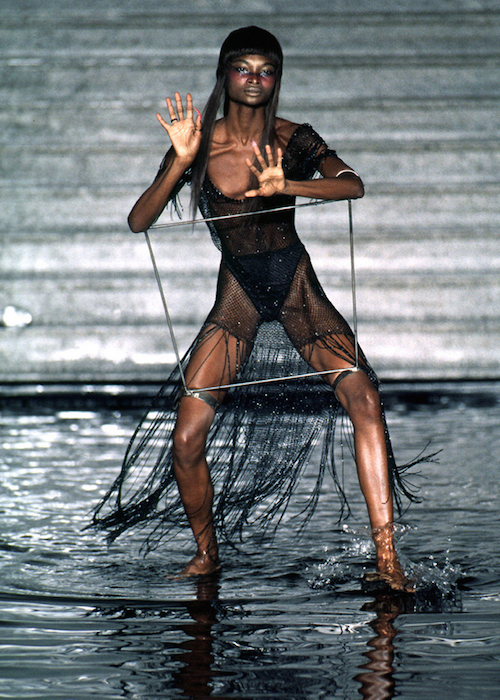
Criticism for McQueen reached fever pitch. His reputation as the bad boy of fashion had begun to cannibalise itself: a growing majority of the fashion press were wondering if McQueen had anything to offer the industry beyond shock value. What he offered next would silence his critics and cement his position as one of the boldest and most talented designers of his era. It would also be the collection that catapulted him to the upper echelon of high couture.
“Dante” was hosted in an historic church in Spitalfields, England — coincidentally, one of the prime hunting spots for Jack the Ripper – and dedicated to his muse, Isabella Blow. Designed as a commentary on war and religion, models strutted down a crucifix catwalk to the sounds of organs clashing with club music and repeated gunfire, with the familiar sounds of missiles sporadically whirring overhead. A skeleton was seated amongst the crowd. Suffice to say, the familiar shock and awe tactics of his earlier collections was readily apparent.
But there were new elements to the McQueen aesthetic that took critics by surprise. Maturity. Romanticism. Elegance. A collection composed of dark silks and luxurious fabrics reminiscent of the Victorian era, with the occasional scandalous piece – military coats emblazoned with images of the Vietnam War, for example — protruding from the collection like a broken bone from under crystalline skin.
Designers such as Philip Treacy and Simon Costin assisted McQueen in making a spectacular range of accessories to accompany the designs. Some bore masks of Christ on the Cross while others opted for a more naturalistic approach that still conjured the image of religious iconography. From antler headdresses to a crown of thorns sculpted from sheared metal, it was work that pushed the boundaries of what people believed McQueen was capable of.
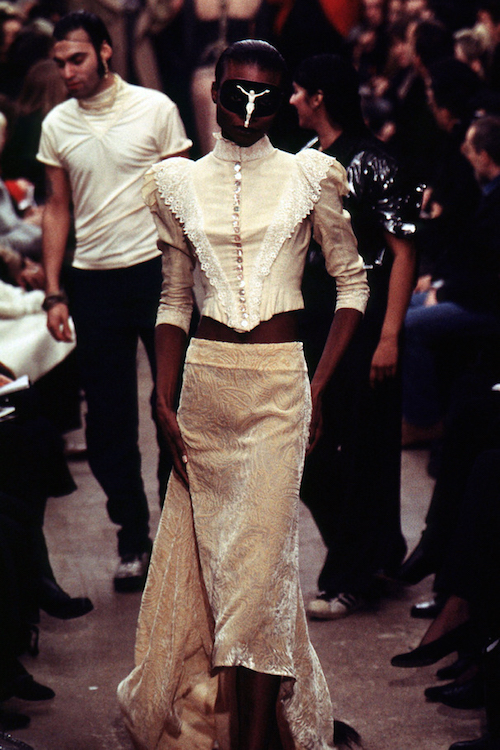
“Dante was the show that made him,” according to collaborator Philip Treacy. “The thing is, everybody loves Alexander now, but they didn’t at the beginning. And what he did that show, suddenly people could see his potential, because it was beautifully done. All that Victorian influence came from Isabella.”
Isabella had done much to induct McQueen into her aristocratic lifestyle. Together with second husband Detmar she introduced him to their estate in private estate in Halles, gifting him with insight into a deeper cultural history and granting him access to the trained birds of prey she would keep on hand as sources of inspiration.
It was a lifestyle McQueen could see himself adjusting to, even for a time; yet he was a tourist in the world of the elite, continuing to live and work out of his studio apartment even as the fashion world sang his praises. But that all changed after Dante.
McQueen won the 1996 British Designer of the Year Award. He sipped champagne with the Prince of Wales and took tea with the Prime Minister. Numerous publications declared him the future of British fashion at a time when the cultural renaissance of the United Kingdom was sweeping the globe, and his newfound status led to social engagements with the likes of Noel Gallagher and Kate Moss.
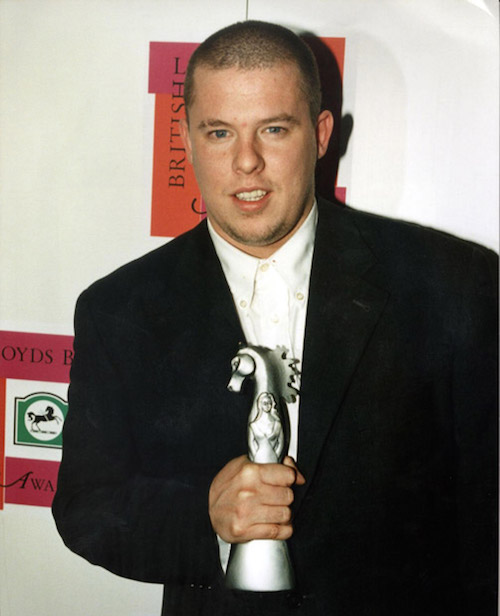
Alexander McQueen was rising to prominence as Lee McQueen faded into the background. Lee Copperwheat, an early friend from his Stepney days, recalled:
“When Lee got the fame, he really began to struggle. He was around a lot of people who would do anything he said, which corrupted him a little. He’d cause trouble and create drama – and really you had to question whether, on occasions, he was really your friend at all.”
There was an innate cruelty to McQueen that only those closest to him ever saw. An earlier roommate had once complained that McQueen left the communal kitchen in a state, and McQueen’s response was to try and stab him with a pair of dress scissors.
Other friends would often be subject to cruel pranks McQueen seemingly felt no remorse over. When directed at the absurdity of the fashion industry – such as when a tailored dress of his was flown to America via Concorde, despite it having only cost one pound to make – there was an wicked charm to his mischievous nature. When directed at his friends, however, there was a sense that McQueen felt no remorse at hurting the people closest to him.
According to one of his close friends, McQueen held at least three different personas:
“There was the sober him – an insecure, unhappy person. Then there was this intermediate one, this brilliant genius who was escaping with the aid of alcohol and drugs; and then this drunken jerk that went into a state of psychotic weirdness that I didn’t understand.”
It would be the next step that pushed McQueen ever further into darkness. In October of 1996, couture powerhouse LVMH announced an enormous shakeup of their company in order to keep their business from stagnating. John Galliano had just accepted a new position at the head of Christian Dior, leaving the creative directorship of Givenchy wide open. To the surprise of almost everyone, it would be Alexander McQueen who inherited the position at the established Parisian house: a man who, at only 27 years of age and with only eight collections to his name, seemed dangerously under-qualified to undertake such a legacy.
His appointment devastated the founder of the brand, Hubert de Givenchy, who once claimed icons like Audrey Hepburn and Jackie O as muses. “I find it total disaster, and I suffer,” he bemoaned, “But what can I do?”
McQueen, for his part, had little interest in the opinions of Givenchy, describing him as “irrelevant”and announcing his intent to dramatically shake up the established order of the Parisian house. His disrespect for French traditionalism shocked and disgusted the press – but no one was more shocked by his actions than Isabella Blow. She had been the one to suggest McQueen to the heads of LVMH and even accompanied him to his initial meetings in Paris. But their relationship was starting to fray. McQueen was growing resentful of being seen as just another feather in the cap of Isabella and desperately wanted to establish a name for himself on his terms. When the position at Givenchy opened up he saw it as an opportunity to do just that, independent of any contact with Isabella.
Isabella, in contrast, believed that after supporting and promoting McQueen for over half a decade she had finally earned her dream position as an in-house muse. When McQueen accepted the role and Givenchy and Isabella discovered there was nothing in it for her she was devastated. Their relationship would never fully recover from the blow.
McQueen was on his own now. But in his isolation the pressure had never been higher. The controversy of his new position meant there was no middle ground in regards to his first collection: it would either be a spectacular success or devastating failure. Making matters worse was that John Galliano, his predecessor, had just unveiled his debut collection at Dior to almost universal acclaim. The pressure had never been greater – and perhaps for the first time in his career, McQueen failed to deliver.
In trying to appease those who believed he had no place in high couture, McQueen had muted himself to the point of banality. The collection – a predominately white-and-gold affair inspired by Greek antiquities – was undoubtedly beautiful, but it lacked the scandal and sensationalism that defined the designer’s work until that point. McQueen himself was quick to dismiss the collection as “crap” and set about recovering his reputation as the bad boy of fashion, delivering a middle finger to all those who relished in his misfortune.
Five weeks later, McQueen showcased a new collection for his personal label. “It’s a Jungle Out There” was a concept the designer had crossed while watching a nature documentary on the brutality of the African savannah:
“I watched those gazelles getting munched by lions and hyenas and said, ‘That’s me!’ Someone’s chasing me all the time, and, if I’m caught, they’ll pull me down. Fashion is a jungle full of nasty, bitchy hyenas.”
The runway showcase was masterful in its anarchy: everything that could have gone wrong did so in the most remarkable of fashions. Naomi Campbell arrived late to the showcase and was fired on the spot, pleasing every other model in attendance; the derelict warehouse hosting the event lost power, forcing a stampede of people outside to crash the venue, knocking over a lit prop and setting fire to the stage. Other designers would have seen it as a disaster: for McQueen, it was a return to the rawness of his earlier shows, a palette cleanser sorely needed after the disappointing reaction to his Givenchy debut.
The atmosphere in the warehouse was electric by the time the show was set to begin, and the designs did not disappoint: models with teased manes strutting down the catwalk in a variety of animal skills, heads ordained with horns and wild makeup that allowed them to tap into their most animalistic nature.

Critic Amy Spindler hailed the return to form by McQueen as a “declaration that he will not be fashion’s victim. No matter what happens at Givenchy, he will survive the jungle in his own house, where he is unmatched for talent, bravado, ideas and cutting skill.”
Reinvigorated by the reception at his personal label, McQueen went on to produce a string of celebrated collections for Givenchy; none more memorable than “No. 13”, an extravaganza that saw two quintessential McQueen moments in the same show. Paralympian Aimee Mullins, a double amputee, appeared as a feature point of the evening, sauntering down the runway in a pair of beautifully ordained wooden prosthetics most in the audience mistook for actual boots.

But it was model Shalom Harlow who appeared as the centrepiece: adorned in a pristine white dress in the middle of a circular platform, the audience were astonished as the platform began to spin and two autonomous robot arms whirred to life beside her, casting both dress and model with dual streams of black and yellow paint, completely indiscriminate in their patterning. Once again, critics revelled in the success of McQueen; Suzy Menkes claimed he had “captured the raw aggression of Britpop and the swaggering showmanship of the art scene” in one fell swoop. McQueen agreed, declaring it to be the best show he had ever done and being so moved at the end he was reduced to tears.
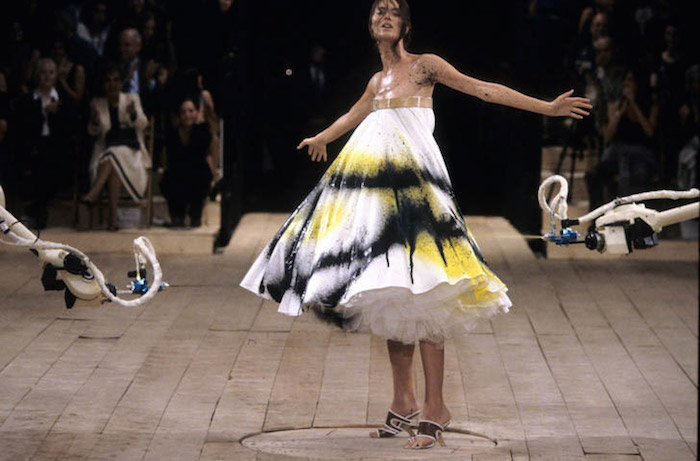
McQueen had done much to earn back the favour of fashion critics. But with each new collection he placed himself under greater and greater pressure to outdo his last. Dividing his time between separate fashion houses in London and Paris was proving a monumental challenge – and in order to compensate, McQueen was increasingly turning to drugs for support.
“Givenchy was the point where Lee started to change, on many levels,” says Simon Costin, his former collaborator. “The stress involved in doing pret-a-porter, couture, and his own label was pretty horrendous.”
Suspicions had begun to arise in professional circles that McQueen was bipolar. “He was up and down a lot more, harder to work with,” Costin recalled. “The people who perhaps answered back… would disappear.”
McQueen had also recently met a new man, George Forsyth, several years younger than him and a stranger to the fashion industry. He was not impressed by what he saw. “The fashion world is the loneliest place on the face of the planet,” he told a British newspaper in the wake of his former partner’s death. “It’s a shallow world full of party people and party ‘friends.’ Lee knew that.”
Theirs was a whirlwind romance: in a single evening McQueen took his new partner to drinks in Paris, dinner in Spain and dancing in Amsterdam. McQueen had little interest in accumulating wealth, preferring to binge on whimsical shopping sprees and vacations that numbered in the hundreds of thousands of dollars. They would party with celebrities and supermodels for days on end, fuelling themselves with alcohol and stimulants to avoid coming back to reality. McQueen seemingly held the mentality of a shark, terrified that if he ever stopped he would drown in his dark thoughts; but as he progressed further into his career those dark thoughts began to
seep out in unexpected ways, affecting all those around him.
Some years previous, McQueen had confided in Detmar about his predilection for sexual degradation; on at least one occasion a partner made him have sex with another man as the partner watched on. It aroused McQueen to be humiliated in this manner: although he confessed he didn’t enjoy the experience it played into his desire to be victimised. “He was very attracted to being abused,” Detmar recalls.
The social aspect of his celebrity lifestyle helped McQueen ignore the trauma of his past. After only a matter of months McQueen and Forsyth were married in Ibiza; Kate Moss and Annabelle Rothschild planned the event in the space of a few weeks and offered their services as bridesmaids.
At the reception, hosted on an extravagant yacht, Forsyth saw the extent of McQueen’s isolation from his former life: as the likes of Noel Gallagher and Sadie Frost toasted the nuptials with an endless stream of champagne, Forsyth became aware that not a single one of McQueen’s family and friends had attended the celebration.
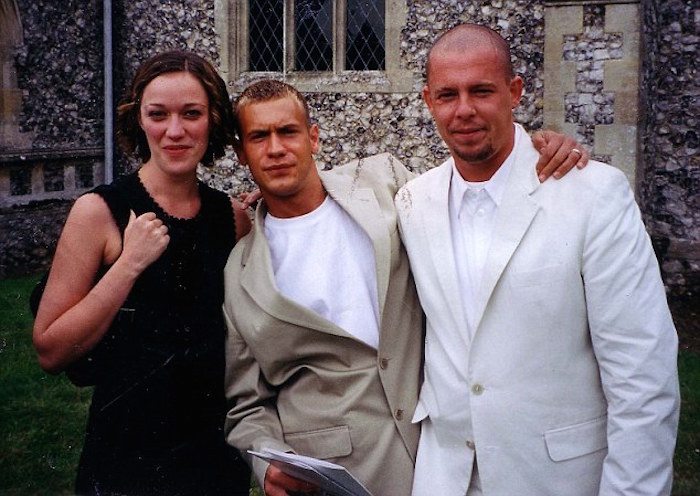
When he and Forsyth separated less than a year later, those same people who had celebrated with Forsyth in Ibiza now refused to acknowledge his existence. The fragility of the fashion industry had become readily apparent to him; and despite his insistence that Alexander McQueen was only a persona, the lines between McQueen’s personal and public identity had become near indistinguishable. McQueen had become the very image of the pampered and preposterous designer he once sneered at in his earlier days.
Yet there were those from his former life still willing to support McQueen. Isabella Blow was now acting as a muse from behind the scenes, and her direct influence would spawn the next chapter of his career. At a dinner party in 1999 she spent the evening sitting next to Tom Ford and the pair spoke on the prospect of McQueen.
Ford was interested. As creative director of the Gucci Group at the time he saw the designer as both a creative and capitalist coup against LVMH, who had recently attempted a hostile takeover of the Gucci Group. Ford had played a key role in staving off their attack and was looking to twist the knife in revenge – and what better way to strike back than by poaching one of the biggest names on the LVMH roster?
It helped that there was no love lost between McQueen and his masters at LVMH by this point. Givenchy was receiving more column inches than any other label but it was not translating into sales. McQueen, who had little interest in the business of fashion to begin with, had failed to turn the fortunes of the stagnant house around – and both parties had begun to announce their displeasure at working with one another.
Gucci struck in December of 2000 with an unprecedented offer: a 51 per cent stake in Alexander McQueen and a promise that McQueen would only have to produce collections for his own house. As long as the designer could create clothes that sell he would have complete and total autonomy over his company.
Publicly, LVMH wished their former designer well; privately they were as livid as a conglomerate could be. McQueen still had a year left on his contract with Givenchy and LVMH ensured that the traitorous McQueen would be working on a shoestring budget for the rest of his tenure.
Not that McQueen particularly cared. He was building up to a runway performance that would demolish every expectation and reaffirm his position as the most talented artist of the modern fashion era. The same season his contract with Givenchy ended — the collection shown in an underwhelming catwalk run designed exclusively for buyers – was the same season he unveiled what many consider to be his crowning achievement: “VOSS.”
The 2001 showcase began an hour late, and shrouded in mystery. The audience was seated around an enormous, reflective plastic box in the centre of the room, uncomfortable anticipation mounting as the most vapid and vain amongst them tried desperately to avoid staring at themselves like parrots lost in a mirror. It was one of the most enjoyable moments in McQueen’s career:
“I was looking at it on the monitor, watching everyone trying not to look at themselves.”
Suddenly the lights went off and the reflection became inverted: where the audience could now see in, the models inside the box were incapable of seeing out. They staggered through the space in sheathed white caps and column dresses scathed in razor clam shells, flourishing red gowns built of ostrich feathers and costumes draped with taxidermied birds. One by one the models would lose themselves like deranged patients of a Victorian madhouse, throwing themselves up against the walls and imitating the blood-curdling screams of the insane.
The show closed with the collapse of a box within the box, revealing a naked model that defied every standard convention of beauty known to the fashion industry so vacantly preening themselves before the show began. Her head encased in a grey mask with a breathing tube hooked to her mouth, the model was at once hypnotic and deliberately repugnant as moths flew from around her body only to find themselves trapped within the wider Perspex prison.
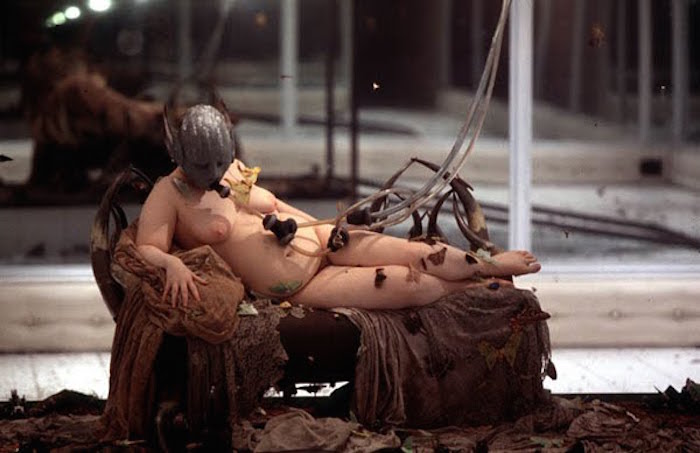
Once again, McQueen was deliberately removing the standards of conventional beauty as a means of exploring the subject matter without bias. Aware of the irony or not, those same preening audience members broke into rapturous applause the the close fo the show.
The response from critics was nothing less than glowing. New York Times writer Cathy Horyn described McQueen as “a great designer who is not only making beautiful clothes, but also responding, like an artist, to the horror and insanity in contemporary culture.”
McQueen was now working exclusively on his own label from his hometown of London. With his enhanced creative freedom and the overwhelming acceptance of critics he was now pushing the boundaries of Alexander McQueen further than ever before: the release of a signature fragrance in 2003 and the return of his menswear line in 2004 – all along with his consistently astonishing runway shows, now clocking in at over half an hour and costing two hundred and fifty thousand dollars on average. The pressure for each show to outdo the last was becoming overwhelming; the emotional and psychological reward diminishing with each subsequent show.
McQueen had reached the point of heavy addiction to compensate, his cocaine habits costing over six hundred pounds a day – a small sum to keep his increasingly dominant demons at bay. His physical appearance had begun to reflect his emotional alterations: his once jutting teeth had been fixed; where cocaine failed to rein in his excess weight, liposuction would succeed. His hair was burned a peroxide blonde and the loose jeans and lad shirts of his past had been replaced with trim bespoke suits and tailored shirts. It was the look of a man much more suited to the high status world of couture – but the Lee McQueen of old was increasingly becoming a distant memory.
Where Lee and Alexander McQueen coincided was in his continued love for his mother and sisters. He would ensure they never had any concerns in the way of money, and would consistently host them at his catwalk shows to sit beside celebrities and members of the fashion elite.
When McQueen accepted the CBE from the Queen in 2003 – the same year he won his third British Designer of the Year Award – he took his mother to the ceremony. His love for his mother is exemplified by an interview question posed to him by her during a candid chat for British newspaper The Guardian:
“What is your greatest fear?”
“Dying before you.”
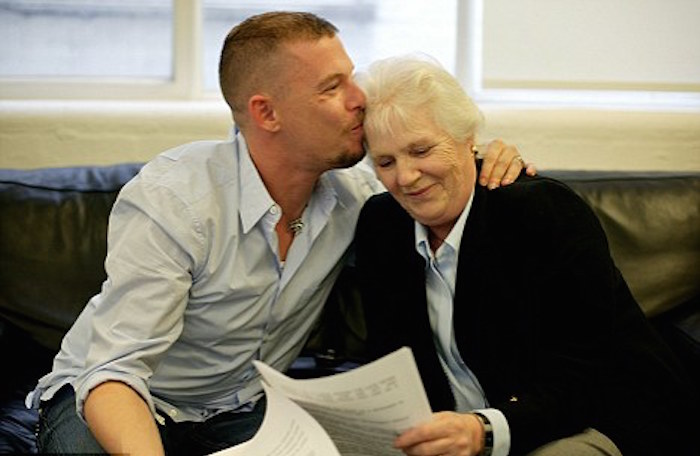
The thought of death had begun to consume him on a grander scale in his later years. McQueen was seeing a therapist to be treated for severe anxiety and depression, and constantly complained of exhaustion. But the gathering melancholy of McQueen was almost trivial compared to the mental state of estranged muse Isabella Blow.
Life had become increasingly insufferable for Isabella since becoming distanced from McQueen. She had been admitted to a mental health clinic in 2003 before separating with Detmar the following year. Her infertility was a great source of distress for her, and during her separation with Detmar she was diagnosed with bipolar disorder and underwent shock therapy to curb her blackening mood. Eventually she reconciled with Detmar, who had never truly left, but after being diagnosed with ovarian cancer shortly after she effectively gave up on life.
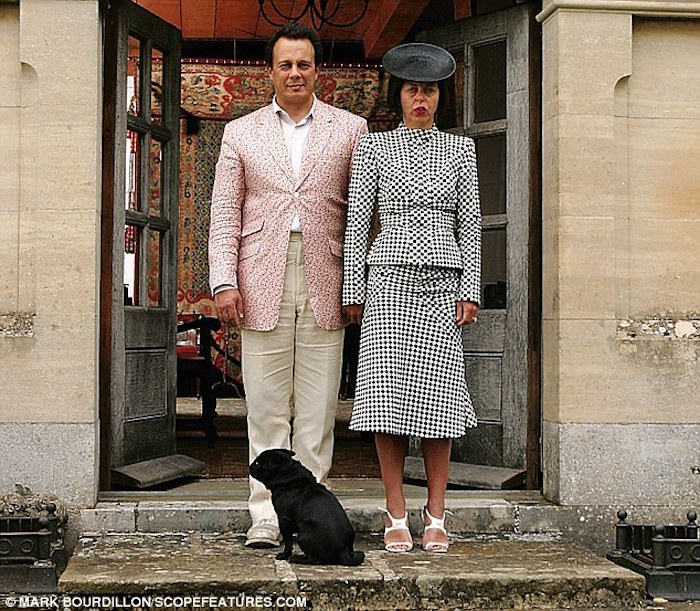
Isabella attempted suicide on no less than three occasions in the span of three months: overdosing on pills, totalling a car, and eventually throwing herself of an overpass known as Suicide Bridge, smashing both ankles and removing her ability to ever wear heels again. While in hospital she would burn her vagina with lit cigarettes, a masochistic punishment for her failure to birth a child.
In May of 2007, Isabella slipped away from a weekend house party after declaring she was going shopping. Instead she was found unconscious on the bathroom floor, having drunk an unconscionable amount of weedkiller. She was rushed to the hospital where she became outraged the nurses had never heard of her. “Google me!” she cried, desperate for the validation she felt she had never received in life. She would die the following day.
When her friends discovered she was dying, those closest to her, including Philip Treacy, came to visit her. McQueen was not amongst them. He had not seen Isabella since a weekend getaway she organised some months previous; instead of reconnecting with his former muse in the way she so desperately wanted he spent the weekend holed up in his room, consumed by cocaine.
McQueen was racked by guilt following her suicide. The press began to insinuate their strained relationship played a large role in her tragic death, an accusation that infuriated the designer; but privately, McQueen was indeed questioning his treatment of Isabella and held deep reservations about the nature of her demise.
Despite his refusal to acknowledge her influence on his career, Detmar believes it was the mirrored demons of McQueen that forced him to stray from his likeminded muse:
“He was frightened of Issie’s darkness, because he had it in himself. So he wouldn’t go there, and I don’t blame him. Issie was always trying to rebuild those early days, but that world had gone.”
Five months after Isabella’s death, McQueen and Philip Treacy hosted a collection showcase in her honour: “La Dame Bleue.” As giant mechanical wings shifted in colour above the runway, models draped in black-and-white feathered dresses and vivacious butterfly swirl hats strode the catwalk in a deliberately understated manner.

It was the perfect send off for their mutual muse, and a fitting testament to their love for this icon of the fashion world; but unlike Treacy, whose relationship with Isabella never soured, it would be the only form of closure afforded to McQueen, who would carry the guilt of her death until his final days.
By 2009 the Gucci Group had succeeded in turning Alexander McQueen into a household name. The brand had opened shops in Mayfair, Milan, New York and Las Vegas; he sold clothes online and created a collection for one of the biggest discount chain stores in America. It was everything and more the designer from Stepney could have possibly hoped for — but McQueen had grown increasingly disillusioned with the vacuous lifestyle that had enveloped him and, in the years before his death, was attempting to make amends.
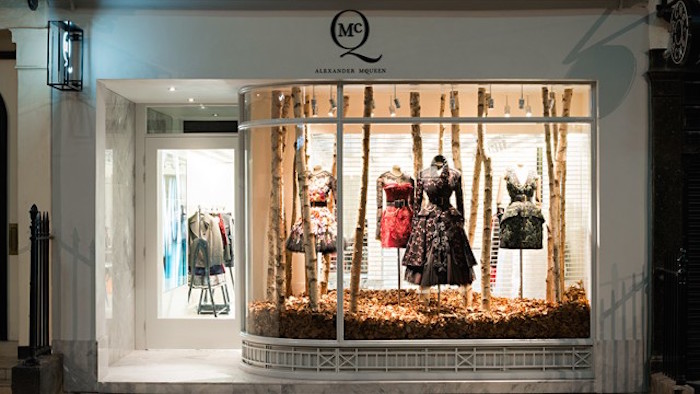
At a Christmas party thrown by former colleague Simon Costin he saw an old friend, Chris Bird, and in a moment of vulnerability confided that he was H.I.V. positive. “I just sort of said to him, ‘Well that was bloody stupid, wasn’t it?” Bird recalled. “And he just said, ‘Yeah.’”
He may have been eager to repent but not to redeem his destructive ways. In the wake of his death a flurry of scandalous allegations surfaced surrounding his final years: despite his H.I.V. status he continued to have unprotected sex with strangers; his masochistic sexual penchants became no less violent even after confessing to his sister the abuse sustained as a child; his drug habits were consistently on the uptake, his cocaine addiction having now reached dangerous levels.
Despite his sustained debauchery, McQueen was consistently producing the best work of his career. “The Girl Who Lived in the Tree” from 2008 was a wondrous spectacle of femininity and lightness, while the collapse of the global economy gave rise to “Horn of Plenty” in 2009 – a scathing indictment of the fear surrounding the fashion industry at the time and the sartorial empires built on advertising with little in the way of substance.
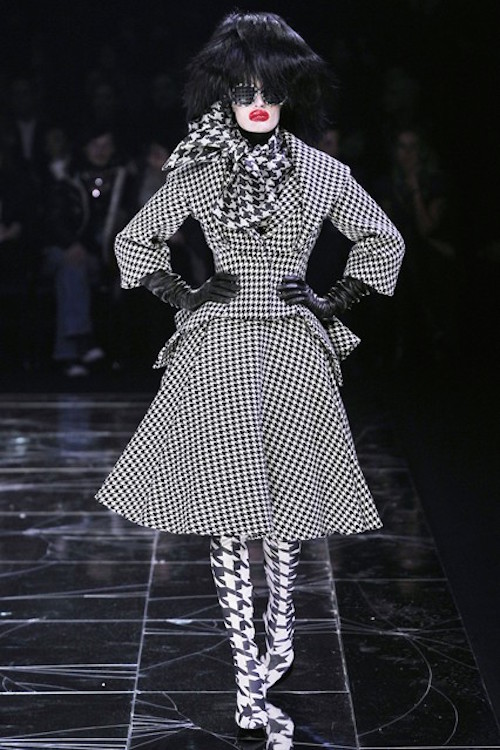
But it was his final collection, “Plato’s Atlantis” in 2010, which cemented his legacy as one of the most visionary designers to grace the modern era. The enormous robotic arms hovering around the catwalk, designed to livestream the show, became a moot point – such was the demand for the collection that the servers crashed from an abundance of traffic.
The attention was deserved. The collection was one of the biggest budgets McQueen had ever worked with: models, their faces distorted to resemble the Atlanteans of myth slinked down the runway in short skirts and satin dresses patterned after all manner of sea creature. It was designed to be the vision of an apocalyptic future, a water world in which only those who have adapted to the sea can possibly survive. But even in those final months of his life, McQueen was unable to separate death from beauty; and in doing so, he created one of his brightest, most vivid, and celebrated collections in the history of his career.
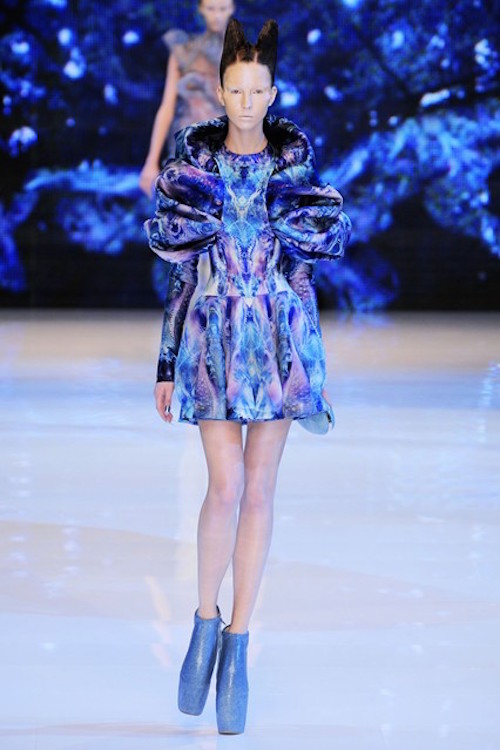
Four months after his triumph in Paris, McQueen’s mother died of cancer. McQueen was devastated to lose the one person upon whom he could consistently count on for support. McQueen shuttered himself away from the world in his Mayfair flat. He was scheduled to attend a launch in ten days; another collection was looming a month away. He had finally succumbed to over a decade of sustained pressure, and the cracks were beginning to show on his Twitter account:
“Been a fucking awful week”
“Somehow I have to pull myself together”
“HELLS ANGELS AND PROLIFIC DEAMONS!!!!!!!!!!!!!!!!!!!!!!!”
On the eve of his mother’s funeral, McQueen committed suicide. In New York, where the elite of fashion had gathered, news of his death filtered through the audience like a ghostly whisper: another of their most talented number gone, consumed by an unrelenting schedule and the fickle nature of a vapid industry McQueen had tried desperately to avoid being sucked into, only to become its quintessential poster child.
But those who knew McQueen were aware there was much more going on under the surface than he would attest. Many in the fashion media maintained it was the tragic death of his mother that prompted the rash attempt at suicide from McQueen – but at an inquest into his death, his doctor testified that McQueen had already tried to kill himself twice before in 2009. He had become isolated by his fame, let down by his friends, and existentially depressed after each fleeting triumph of a show. The death of his mother was just the final excuse to end a life in which he felt he had “very little to live for.”
The funeral was as appropriately gothic, religious and deathly romantic as one could imagine. Yet there were clear dividing lines between the attendees. On one hand were the celebrities and models who had known Alexander McQueen the designer: bold, daring, challenging the status quo of an industry he could forever see the flaws in. On the other side were the family and friends of Lee McQueen: the working class boy from Stepney in East End who achieved more than he could have ever dreamed of in his life. It was a dichotomy of character McQueen could never quite overcome: plagued by the demons of his past yet unable to find solace in the persona he shared to the world, McQueen left this world feeling as if he never held a true place in it.
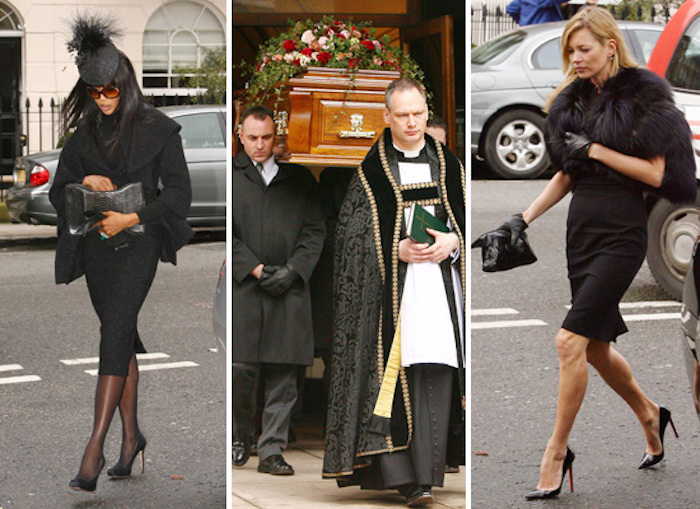
Those in attendance of the funeral – some 1500 people – would disagree. And while McQueen would have undoubtedly been touched by their outpouring, it was their journey into the church that would have brought him the most joy: because before Anna Wintour took the stage or critic Suzy Menkes eulogised the “wispy lightness” of his printed chiffon tailoring, these titans of the fashion industry were forced to hobble past paparazzi on a long cobblestone stretch, their embarrassingly decadent and oversized heels near crippling them as plain-dressed family and friends from Stepney strode past the supermodels and celebrities with a shake of their heads.
No doubt McQueen would have pissed himself laughing.
Stay tuned for another Renegade next week, in celebration of our upcoming hardcover. Watch this space.

